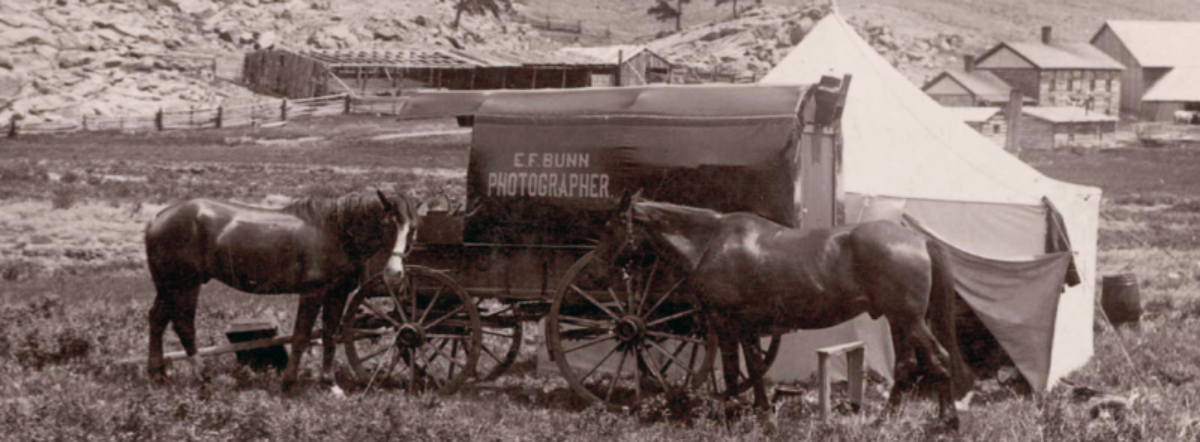
Alfred E. Rinehart found his niche as a portrait photographer at the start of his career and remained faithful to his craft for decades. His work documents Denver’s eminent political figures and their families, along with the city’s ordinary citizens.
A. E. Rinehart was born in 1851 in Tippecanoe County, Indiana to John Byers Rinehart and Mary Cooly Rinehart. His siblings included younger brother, Frank A. Rinehart, who would gain fame for his photographic portraits of Native Americans.
A. E. Rinehart learned photography from Charles C. Wright in Lafayette, Indiana. Around 1875, Rinehart relocated to Denver, taking a position with George W. Kirkland. Coincidentally, Wright moved to Denver in the 1880s, where he continued his photographic career. Rinehart developed his skill as a portrait photographer while working as an operator in the studio of Charles Bohm in Denver.
On March 29, 1880, after five years with Bohm, Rinehart joined William Henry Jackson, in the firm Jackson & Rinehart. Jackson devoted his time to landscape photography while Rinehart took charge of portraiture. They shared darkroom facilities and staff, with Frank A. Rinehart employed as a printer. By early December, the partnership was dissolved by mutual consent.

Rinehart married Denver socialite, Bessie Mode, on May 11, 1880. She wore a wine colored bridal dress trimmed with silk of the same color. After her marriage, Bessie Rinehart seemed to spend more time visiting friends and relatives in the East and South than she did in Denver. The couple divorced in 1893.
Almost immediately after his divorce, Rinehart planned to marry Mrs. Dora Ellen Thorworth, unaware that a new law required divorcees to wait one year before remarrying. On the day of his marriage, the county clerk’s office denied Rinehart’s application for a marriage license. Rinehart returned to the Clerk’s office later that day with a judge. With a wink and a nod, the marriage license was issued and the couple married that evening. Dora Rinehart took up cycling, breaking several long-distance records. In 1898, A. E. Rinehart secured a divorce on the grounds of desertion.
Rinehart’s business was much more successful than his love life. In December 1887, he opened a new studio, the largest photography establishment in the city, on the upper floor of Wolfe Londoner’s grocery store on Arapahoe Street. The January 1, 1888 issue of the Rocky Mountain News reported on the opening of the studio in great detail, describing the decor of the handsome reception room, the large skylights and the movable case holding backgrounds in the operating room, the printing room with storage for 40,000 negatives, and Rinehart’s private artist’s studio. Rinehart presided over all portrait sessions. Long-time employees John Lehman headed the printing room, Charles Nast oversaw retouching and Mrs. Lehman framed portraits in the finishing room.


The Wellington Randolph family visited Rinehart’s new studio shortly after it opened. Randolph (1848-1909) was born in Virginia and moved to Colorado in the 1880s. He earned a living as a janitor. Tillie was the first of eventually three children.
Another portrait made in the new studio shows Blanche Wannemaker Webber. In posing Mrs.Webber, Rinehart chose to make a profile view from the back to show off the sitter’s long tresses. This portrait was probably made soon after Miss Wannemaker’s marriage to Republican political figure Dewitt C. Webber. After thirteen years of marriage, Mrs. Webber filed for divorce, claiming extreme cruelty, general unkindness and desertion. The story does not end there, however, about a year after the divorce, Blanche’s father hired two men to kill his former son-in-law. Mr. Webber learned of the plot and was able to avoid the purported killers.
In 1890, Rinehart claimed to have photographed between thirty and forty thousand Denverites. He kept all of his negatives, so customers could request additional prints at a later date. Early in his career, Rinehart thought it might be best to have customers purchase their negatives, as he believed many would never be used again, but that was not standard studio practice.
As early as December 1897, Rinehart placed a brief advertisement in Wilson’s Photographic Magazine, offering his studio for sale. In June 1910, Rinehart placed another notice, this time more detailed, outlining the contents of his studio including Dalimeyer lenses, cameras up to size 20 x 24, and backgrounds painted by the prominent New York City artist, Lafayette W. Seavey. Stating he planned to retire, the asking price was $2,500. Rinehart was sixty years old.
In 1912 Rinehart moved from his long-time studio on Arapahoe Street to a smaller space on Welton Street. He died at St. Joseph’s Hospital on May 14, 1915 from complications associated with appendicitis. He is buried at Denver’s Riverside Cemetery.

Inventory of the A. E. Rinehart collection at the Denver Public Library.
My thanks to History Colorado staff Jori Johnson and Cody Robinson, who always help make my onsite visits pleasurable and Viviana Guajardo, for her scanning expertise. Additional thanks to Vanya Scott, Curatorial Assistant, Golden History Museum & Park, Golden, CO. Special thanks to Beverly W. Brannan, recently retired photography curator at the Library of Congress, for editing this post.
